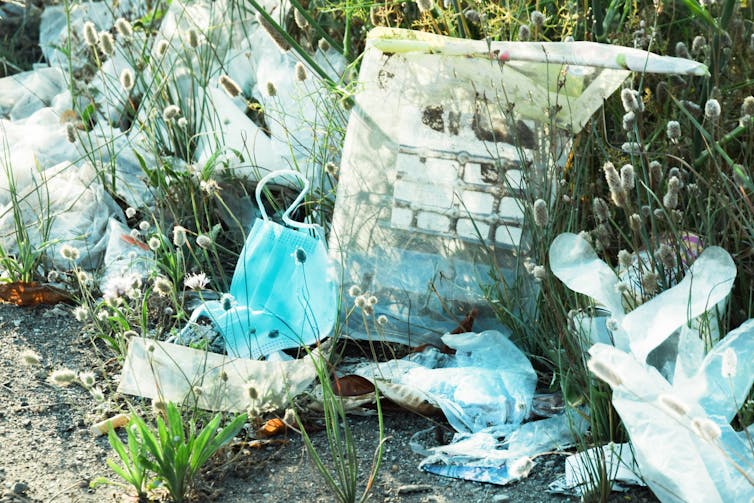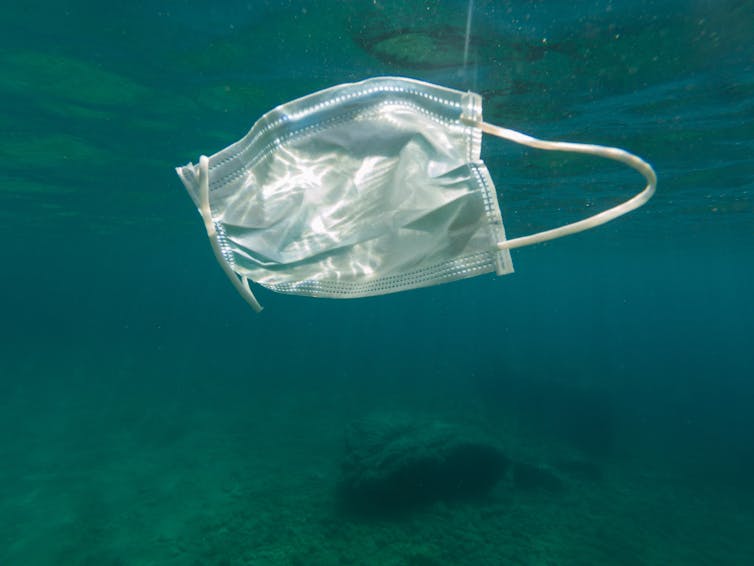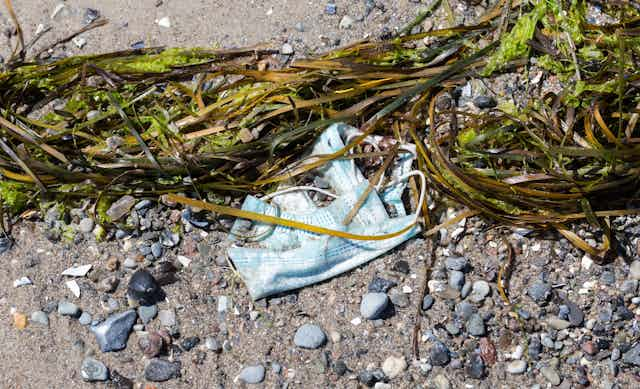Face coverings are now a legal requirement in many public spaces around the world. But even before they became compulsory, masks were causing litter problems on land and at sea.
One February beach clean in Hong Kong found 70 masks along 100 metres of shoreline, with 30 more appearing a week later. In the Mediterranean, masks have reportedly been seen floating like jellyfish.
Despite millions of people being told to use face masks, little guidance has been given on how to dispose of or recycle them safely. And as countries begin to lift lockdown restrictions, billions of masks will be needed each month globally. Without better disposal practices, an environmental disaster is looming.
The majority of masks are manufactured from long-lasting plastic materials, and if discarded can persist in the environment for decades to hundreds of years. This means they can have a number of impacts on the environment and people.
Hazardous to people and animals
Initially, discarded masks may risk spreading coronavirus to waste collectors, litter pickers or members of the public who first come across the litter. We know that in certain conditions, the virus can survive on a plastic surgical mask for seven days.

Over the medium to long term, animals and plants are also affected. Through its sheer mass, plastic waste can smother environments and break up ecosystems. Some animals also cannot tell the difference between plastic items and their prey, subsequently choking on pieces of litter.
Even if they do not choke, animals can become malnourished as the materials fill up their stomachs but provide no nutrients. Smaller animals may also become entangled in the elastic within the masks or within gloves as they begin to break apart.

Plastics break down into smaller pieces over time, and the longer litter is in the environment, the more it will decompose. Plastics first break down into microplastics and eventually into even smaller nanoplastics. These tiny particles and fibres are often long-lived polymers that can accumulate in food chains. Just one mask can produce millions of particles, each with the potential to also carry chemicals and bacteria up the food chain and potentially even into humans.
Littered areas also tend to encourage further littering, making the problem worse.
What you should do
In March, the World Health Organization estimated that 89 million additional disposable masks were needed globally per month in medical settings to combat COVID-19. In addition, a recent working paper by the Plastic Waste Innovation Hub at University College London has put the current domestic demand for the UK at 24.7 billion masks a year. However, the demand for domestic face masks in the UK drops dramatically – to around 136 million a year – if only reusable masks are used.
But even with reusable masks, their specific design and how you choose to clean them makes a difference. The University College London team examined the manufacture, use and disposal of masks that were disposable, reusable, and reusable with disposable filters, to calculate their overall environmental impact. They found machine washing reusable masks with no filters had the lowest impact over a year.

Hand washing masks increased the environmental impact as – while machine washing uses electricity – manual washing uses more water and detergent for each mask. Disposable filters also increase the environmental impact because the small filters are often made from plastic similar to the disposable masks, with a filter discarded after every use.
Perhaps surprisingly, the working paper estimates that hand washing reusable masks with disposable filters had the highest environmental impact overall – higher even than using fully disposable masks.
With all of this in mind, we should take these steps to reduce the impact of wearing a face mask:
Use reusable masks without disposable filters. Machine wash them regularly following the instructions for the fabric.
Try to carry a spare so if something goes wrong with the one you’re wearing you don’t need to use or buy a disposable mask.
If you do need to use a disposable mask, take it home (maybe in a bag if you have to take it off) and then put it straight into a bin with a lid. If this isn’t possible, place it in a proper public bin.
Don’t put disposable masks in the recycling. They can get caught in specialist recycling equipment and be a potential biohazard to waste workers.
Whatever you do, don’t litter them!

